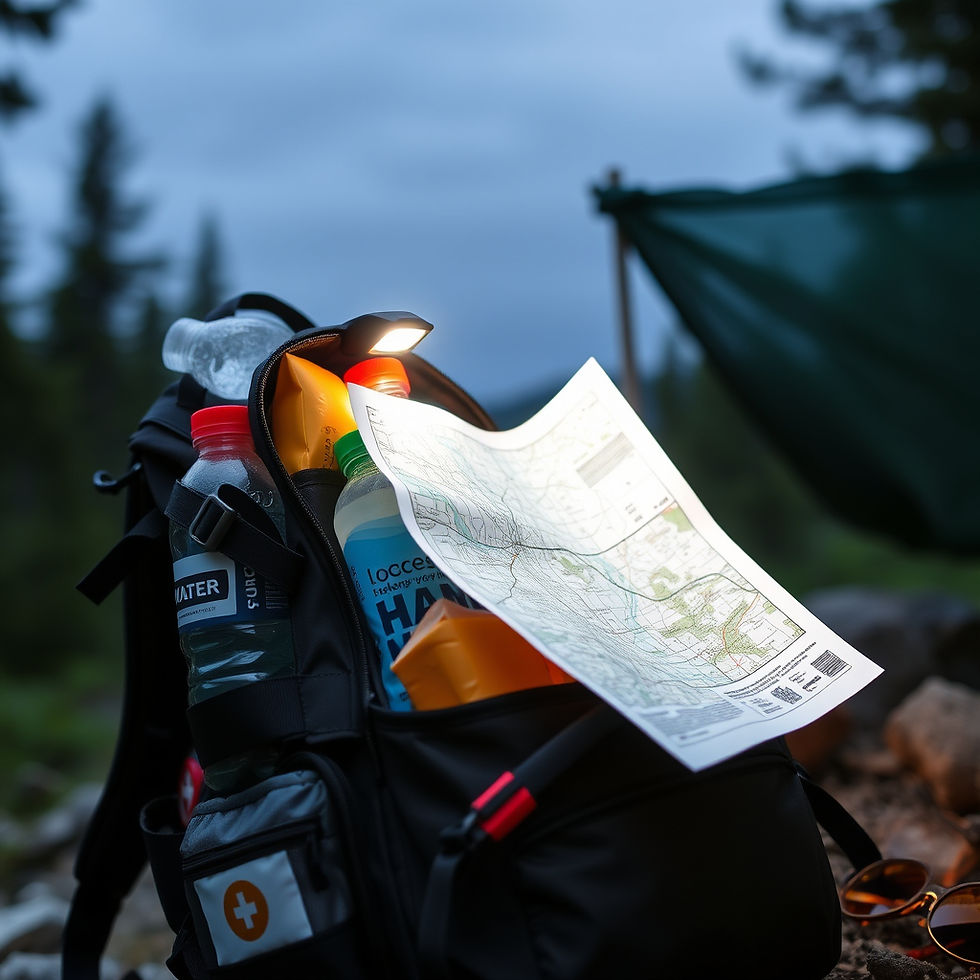What are the 10 Essentials?
- tmschales
- May 30
- 3 min read
Updated: Jun 5

The "10 Essentials" of backpacking are a set of items that help ensure safety, survival, and preparedness in the outdoors. Although they were developed for backpacking and mountaineering- these items should be with you even on a day hike, bike ride or any other trip in the wilderness- especially in the Pacific Northwest where changing weather patterns in the mountains and wildfires are unpredictable.
Why would I need these things for a day hike? Many of the horror stories of wilderness survival experiences began as day hikes; where "I'm only going a few miles" turns into an overnight or more when something unexpected happens.
There are many ways to carry these items and still be "lightweight".
For ease and haste, I keep these items packed up and ready to throw into my pack in a "go bin". I test & charge everything after using and before putting away, and test again before taking on a new trip.
I use a laminated gear packing checklist with a dry erase marker for every trip to verify that I haven't forgotten, lost, or damaged.
Originally developed by The Mountaineers in the 1930s, the list has evolved into a "systems" approach rather than specific items. Here's the modern version, with a few of my personal recommendations highlighted:
🥾 The 10 Essentials for Backpacking
Navigation
Waterproof paper Map, compass, GPS device, or smartphone with GPS and offline maps.
Why a paper map? It won't die like an electronic device! Using one device for photos, mapping, and emergencies increases the likelihood of a drained battery.
Why offline maps? Often times the mapping apps will not open outside of cell signal and need to be downloaded before your trip.
Always know where you are and how to get where you're going.
Headlamp (and extra batteries)
Reliable light source for night travel or emergencies.
Headlamps keep your hands free.
Sun Protection
Sunglasses, sun-protective clothing, and broad-spectrum sunscreen for body and lips.
Prevents sunburn, snow blindness, and long-term skin damage.
First Aid Kit
Include bandages, antiseptic, pain relievers, blister treatment, and any personal medications. I strongly recommend Leukotape!
Know how to use everything in the kit- AND where it is located inside of your kit for quick access.
Knife (and repair kit) *CLICK HERE FOR RECOMENDATIONS
Multi-tool or knife for gear repair, food prep, and emergencies.
Include duct tape, zip ties, and any tools specific to your gear.
Fire
Waterproof matches, lighter, and/or firestarter.
Essential for warmth, cooking, and signaling.
Shelter
Tent, bivy sack, tarp, or emergency space blanket.
Protection against exposure if stranded.
Extra Food
At least one day’s worth of high-calorie, ready-to-eat food.
Energy reserves in case of delay or emergency.
Extra Water (and purification method)
Carry more than you think you need and a way to treat water (filter, tablets, etc.).
Dehydration is a common risk.
Extra Clothes
Layering system including insulation and rain gear.
Weather can change rapidly, especially at altitude.
NO COTTON! Wool is my personal favorite, because it retains thermal properties even when wet. It can be pricey and I have gradually switched my gear to all wool over many years. Tech fabrics also have fast drying properties- cotton does not dry fast, does not retain heat, and can be deadly in our wet PNW areas.
If you're taking electronics, I also recommend taking a backup battery bank and any cords you may need, as well as testing it out beforehand to see how much of a charge you get out of it.
An emergency SOS or satellite device is strongly recommended. Although some new phones are beginning to offering satellite communication, that is one more thing you cannot do with a dead battery. I use the Garmin in reach mini. You definitely want to practice and set these devices up BEFORE you leave cell service.
Although it isn't included on the original list- having a plan (your intended route, your potential emergency routes, sheriff's office that covers your wilderness area, where you will park, and your intended entry date/time and exit date/time) are also essential, and sharing that plan with a responsible adult is most certainly essential. (We will cover this more in a follow-up post about the 7 Leave No Trace (LNT) Principles).
These essentials are about being self-reliant and prepared. I strongly recommend everyone in the party has their own version of the 10 essentials in case of loss, injury, or destruction. Even on short hikes, they can make the difference in an emergency or unexpected situation.
What other essentials are you carrying on your trips? What questions do you have about the 10 essentials?







Comments